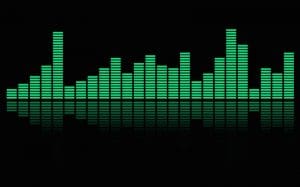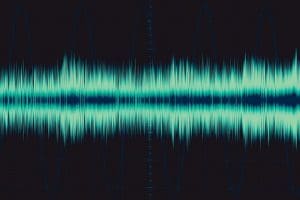We recently talked about how the conversion from analog to digital works and explained some of the basic terminology associated with digital audio files. In this article, we are going to look at how different digital audio compression algorithms work to reduce file size so that files can be shared more easily.
The Basics of Digital Audio
 As we explained previously, sampling an analog audio waveform at CD-quality resolution requires 44,100 samples per second with a resolution of 16 bits for a pair of stereo channels. This results in a data stream that is 1,411 kilobits per second. For a one-minute long song, you’d need to store 84,672,000 bits of information. That’s about 50 megabytes for a five-minute song.
As we explained previously, sampling an analog audio waveform at CD-quality resolution requires 44,100 samples per second with a resolution of 16 bits for a pair of stereo channels. This results in a data stream that is 1,411 kilobits per second. For a one-minute long song, you’d need to store 84,672,000 bits of information. That’s about 50 megabytes for a five-minute song.
When we store audio in an uncompressed format, the information in the file doesn’t affect the size of the file. We could have a track containing a recording of a symphony orchestra, an audio test track or the last, last, last performance of the Rolling Stones. The size of the file will be the same if the track length is the same.
Lossless Audio Compression
 Reducing file size has always been a concern when it comes to transmitting a file. Back when we had dial-up internet service, it would take hours to download a whole song in an uncompressed format. Acoustic modems had an optimal transfer rate of about 300 bits per second. High-speed analog modems reached a peak of 48 kilobits per second using data compression algorithms. To transfer high-quality audio, it would take about 30 seconds for every second of music. See the problem?
Reducing file size has always been a concern when it comes to transmitting a file. Back when we had dial-up internet service, it would take hours to download a whole song in an uncompressed format. Acoustic modems had an optimal transfer rate of about 300 bits per second. High-speed analog modems reached a peak of 48 kilobits per second using data compression algorithms. To transfer high-quality audio, it would take about 30 seconds for every second of music. See the problem?
One of the most popular and well-known file compression methods is to zip a file. Zipping a file analyzes the content of the file and replaces repeated strings of data with a shortcut to identical information. When you unzip the file, you get the original back without any modification.
In terms of audio compression formats, the most popular lossless formats are Free Lossless Audio Codec (FLAC), Apple Lossless Audio Codec (ALAC) and the Monkey’s Audio (APE) format in a distant third place.
In terms of compression, converting our 70.69 megabyte audio file to FLAC results in a file size of 37.5 megabytes. This is a reduction of about 50 percent with no loss of sound quality, accuracy or detail.
Lossy Audio Compression
 Whether you are trying to shrink an audio file or a photograph, one of the easiest ways to reduce the file size is to throw away some of the detail in the original file. For audio files, this often means limiting high-frequency information and reducing the detail of or eliminating low-level signals.
Whether you are trying to shrink an audio file or a photograph, one of the easiest ways to reduce the file size is to throw away some of the detail in the original file. For audio files, this often means limiting high-frequency information and reducing the detail of or eliminating low-level signals.
If we convert our original audio file to a 320 kbps MP3 file, the file shrinks to an amazing 16.0 megabytes. We do so by throwing out audio information that is difficult to hear. For example, if there is a loud guitar riff in one channel, the compression algorithm can dramatically reduce the detail of the relatively low-level audio information in the other channel without much change in the perceived quality of the playback. This is called perceptual audio encoding because the algorithm specifically affects information that is more difficult to hear (or perceive).
At a compression rate of 320 kbps, most listeners can’t tell the difference between the original file and the compressed version. As the compression increases, the differences become much more apparent. We start to lose high-frequency information and detail.
 If we want to shrink the file further, we can convert it to a 128 kbps MP3 file. The benefit of extreme data compression is that our audio file now has a size of 6.59 megabytes. At this size, the song can be attached to an email without much concern for bandwidth or download time on a modern broadband internet connection.
If we want to shrink the file further, we can convert it to a 128 kbps MP3 file. The benefit of extreme data compression is that our audio file now has a size of 6.59 megabytes. At this size, the song can be attached to an email without much concern for bandwidth or download time on a modern broadband internet connection.
The most popular lossy file compression formats are MP3 (formerly MPEG-1 Audio Layer III or MPEG-2 Audio Layer III), Adaptive Transform Acoustic Coding (ATRAC), Advanced Audio Coding (AAC) and Windows Media Audio (WMA).
Does File Size Matter?
 As mentioned, audio compression algorithms were created to allow us to transmit audio over limited-bandwidth connections. Today, data storage is incredibly inexpensive. You can buy a 128 GB USB memory stick for less than $25. You can store about 400 hours of high-quality FLAC audio on a 128 GB memory stick. At the same time, internet bandwidth speed is at an all-time high. Most smartphones with LTE can download data at 150 mpbs. That’s faster than most people’s high-speed internet at home. Downloading a 37 megabyte file over a connection like that takes about five seconds.
As mentioned, audio compression algorithms were created to allow us to transmit audio over limited-bandwidth connections. Today, data storage is incredibly inexpensive. You can buy a 128 GB USB memory stick for less than $25. You can store about 400 hours of high-quality FLAC audio on a 128 GB memory stick. At the same time, internet bandwidth speed is at an all-time high. Most smartphones with LTE can download data at 150 mpbs. That’s faster than most people’s high-speed internet at home. Downloading a 37 megabyte file over a connection like that takes about five seconds.
Unless you are bandwidth-limited, you may as well download your music in at least CD-quality FLAC or an uncompressed WAV format. That way, you get the best sound quality possible from your audio system. If you have questions about how many tracks you can store on a memory stick or what digital media file formats are compatible with your car radio, visit your local mobile enhancement retailer. They should be able to answer any questions you may have.
This article is written and produced by the team at www.BestCarAudio.com. Reproduction or use of any kind is prohibited without the express written permission of 1sixty8 media.
